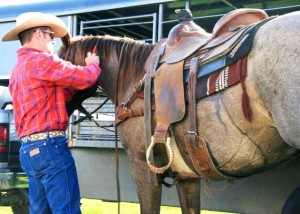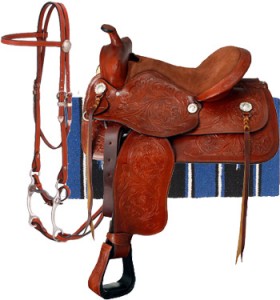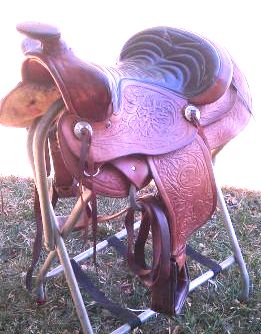 For the beginning horse enthusiast, the task of buying all the stuff that is needed for horse ownership can be exhausting. It can also drain your bank account very quickly, and without prior experience you might find yourself buying things you will never use, or horse items that aren’t the best quality. This article will provide you with the best websites to find tack and used tack, some tips on choosing what to buy, and some guidelines to hopefully prevent you from spending too much.
For the beginning horse enthusiast, the task of buying all the stuff that is needed for horse ownership can be exhausting. It can also drain your bank account very quickly, and without prior experience you might find yourself buying things you will never use, or horse items that aren’t the best quality. This article will provide you with the best websites to find tack and used tack, some tips on choosing what to buy, and some guidelines to hopefully prevent you from spending too much.
First of all, if you don’t have the money to buy the entire list of four hundred plus items that are associated with caring for a horse, don’t be discouraged. You can prune that list down to just the essentials and be able to save a lot of money and still function just fine. Depending on the discipline and level that you plan to participate in with your horse, you might add a few more things as needed, but these are the basics for horse tack: halter, lead rope, bit, bridle, saddle, saddle pad, brush, hoof pick, feed scoop, and feed bucket. That’s just ten items!
Of course, if you plan to show, the list will be longer. If you plan to keep the horse at your own farm rather than at a boarding stable, the list might include fencing materials, stall bedding, hay, feed, and a water tank. And if you’ve got the unlimited funds to be able to spoil your horse and yourself, by all means buy everything! This is just a practical list for the beginning rider who doesn’t have a lot of extra cash to spend and wants to just be able to have a horse to ride and enjoy.
Some of the best sources for horse tack and supplies are www.Horse.com, www.DoverSaddlery, www.ValleyVet.com, www.StateLineTack.com, and www.UnitedVetEquine.com. You will probably find better deals at these websites on halters, lead ropes, bits, and brushes than you would find at your local feed store or tack shop.
When it comes to the bigger items, like a saddle and bridle, I would suggest buying used items rather than new. My reason is that the older saddles are usually much more well-made and better quality than many of the mass-produced plastic-looking new ones that are marketed today. I would suggest looking at www.craigslist.org in the Farm & Garden section, and searching for a saddle in your area. That way, you can go look at the saddle and inspect it before you buy. I have bought kid saddles off of www.ebay.com, and I think that if you watch who you buy from (choose a seller with excellent ratings who is willing to send you extra photos and exact measurements, etc.) you will have good success with that site. You can also find good used tack in facebook groups that are specifically for selling and swapping used tack items, but if you don’t know the person and they have no way to rate them on honest selling, that might be more risky than ebay.
 Let me show you a few examples to show what I would look for in a saddle. This is a complete western saddle package—you get the saddle, bridle, girth, and saddle blanket. It is priced very affordably at $369 for a 14 or 15 inch saddle set at www.ChicksSaddlery.com. It would be a great starter set, and says right on the ad: “The perfect package for the beginner or occasional rider.”
Let me show you a few examples to show what I would look for in a saddle. This is a complete western saddle package—you get the saddle, bridle, girth, and saddle blanket. It is priced very affordably at $369 for a 14 or 15 inch saddle set at www.ChicksSaddlery.com. It would be a great starter set, and says right on the ad: “The perfect package for the beginner or occasional rider.”
There are just a few things I would note, though, before buying it. The saddle blanket is just that: a blanket….it’s not of sufficient thickness to pad a horse without putting something underneath with more support and padding. You will still need to buy a good saddle pad to put underneath it. The girth is also an economy model, just a cotton strand cinch of moderate width, which is acceptable for light riding but would not hold up well in extreme trail riding, barrel racing, or calf roping, for instance. It’s also not as comfortable on the horse as a neoprene type of girth. And the bit is a basic curb bit, which isn’t useful for every horse or rider, and you will most likely want to replace it.
 Or here’s a saddle on the Omaha craigslist for only $250, it’s a 14 inch Big Horn brand, good fleece, good leather, a little out-dated, but still very functional and really all you need to spend a day on the trails. You would want to measure and see if it was approximately a good fit for your horse, and keep in mind that if it didn’t work out once you purchased it, you could most likely re-sell it again for the exact same price. That’s one of the advantages of buying used…the saddle doesn’t lose any value at all by having one more owner.
Or here’s a saddle on the Omaha craigslist for only $250, it’s a 14 inch Big Horn brand, good fleece, good leather, a little out-dated, but still very functional and really all you need to spend a day on the trails. You would want to measure and see if it was approximately a good fit for your horse, and keep in mind that if it didn’t work out once you purchased it, you could most likely re-sell it again for the exact same price. That’s one of the advantages of buying used…the saddle doesn’t lose any value at all by having one more owner.
You could also look into the neoprene style of saddle, if you like that look. Personally, I don’t think there is a good replacement for leather, as I just prefer the durability, look, and feel of riding a leather saddle. They do run cheaper, though, and many people seem to enjoy riding them, so you could choose that option.
As far as bridle headstalls are concerned, you can choose between the ones with browbands, throatlatches, or the one-ear style. If they fasten with Chicago screws instead of the leather ties, you will want to take extra caution, as I’ve had them unfasten while riding. A dab of clear nail polish on the screw before you tighten it will help secure it. Or just replace the screw altogether with a length of nylon shoelace or leather cord, it will hold much better. You can sometimes find used bridles at bargain prices, but the new ones in the feed store are usually priced pretty fairly.
A good bit is perhaps the most important choice you will make. There are literally hundreds to choose from, they are as individual as the horses who wear them, and putting the wrong bit on a horse can mess things up faster than anything else. When you buy a horse, it’s best to ask what type of bit the horse is used to and stick with that one. If you don’t really know what kind of bit to use, it’s best to try the mildest one possible, and see if that works. A snaffle bit is a good place to start, no twists, no shanks, and see if the horse is comfortable and responsive in it. If you need more control and stopping power, a snaffle with shanks is a very good bit to transition to a curb or shanked style bit. Make sure the joints at the corner of the horse’s mouth don’t pinch his lips, and make sure the bit is wide enough (5 inches is an average width for a horse bit). Curb bits are just fine for a horse that has been trained to neck rein and is comfortable in a shanked bit. But forcing a horse to change bits is very confusing and hard on a horse.
As far as all of the extras in the horse catalogs, don’t get carried away with buying things you don’t need. If you’re a casual trail rider, you don’t need a fancy grooming kit filled with forty different brushes. A simple medium-stiff bristle body brush is good, and I just use a regular hard plastic-bristled hair brush for the mane and tail, as they are strong enough to work out tangles but not so harsh it will break the hairs. Unless your horse has a specific need, you can cut out a lot of the cost just by staying with very basic supplies.
It is my hope that this article will be an encouragement to the beginning rider who doesn’t have a whole lot to spend but wants to embark on the adventures of having a horse in their life. It can be very costly, depending on your location and plans for your horse. But it can also be really cheap, if you have a place to keep a horse that doesn’t cost very much, and if you just plan on riding for pleasure. It’s my wish that every girl who grows up wanting a horse of her own will someday see those dreams come true.

